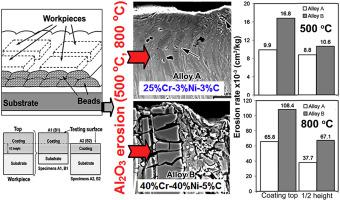Our official English website, www.x-mol.net, welcomes your
feedback! (Note: you will need to create a separate account there.)
High-temperature solid particle erosion of Cr–Ni–Fe–C arc cladded coatings
Wear ( IF 5.3 ) Pub Date : 2020-11-01 , DOI: 10.1016/j.wear.2020.203439 B.V. Efremenko , K. Shimizu , N. Espallargаs , V.G. Efremenko , K. Kusumoto , Yu.G. Chabak , A.G. Belik , V.V. Chigarev , V.I. Zurnadzhy
Wear ( IF 5.3 ) Pub Date : 2020-11-01 , DOI: 10.1016/j.wear.2020.203439 B.V. Efremenko , K. Shimizu , N. Espallargаs , V.G. Efremenko , K. Kusumoto , Yu.G. Chabak , A.G. Belik , V.V. Chigarev , V.I. Zurnadzhy

|
Abstract In the present work two arc weld cladded alloys A (C3Cr25Ni3Si3) and B (C5Cr40Ni40Si2BZr) were tested under solid particle erosion at higher temperature (500 °C and 800 °C). The alloys were cladded using flux-cored strips PL-AN-101 and PL-AN-111, respectively. Alloy A is hypo-eutectic with a γFe + carbide M7C3 eutectic and austenite matrix. Alloy B is hyper-eutectic comprising coarse columnar M7C3 carbide, graphite flakes and an inhomogeneous austenitic matrix. It was found that alloy A presented a lower erosion rate of 18–41% at 500 °C due to the energy-consuming mechanisms of erosion (ploughing and poly-deformation). Alloy B was eroded by a low-cycle mechanism of carbide cracking/chipping. By increasing the testing temperature to 800 °C, the erosion rate of the alloys increased by 4.2–6.7 times. The erosion mechanism of the alloys at 800 °C was the formation and abrupt spalling of a depressed defective subsurface layer consisting of carbide fragments. Alloy A performed with a lower erosion rate of 39–44% at 800 °C due to a lower thickness of the defective layer. Oxidation had a negligible effect on the erosion rate of any of the alloys. The erosion rate of the coatings decreased with the distance from the coating top due to refinement of the carbide M7C3 and graphite inclusions.
中文翻译:

Cr-Ni-Fe-C电弧熔覆涂层的高温固体颗粒侵蚀
摘要 在目前的工作中,两种电弧焊复合合金 A (C3Cr25Ni3Si3) 和 B (C5Cr40Ni40Si2BZr) 在较高温度(500 °C 和 800 °C)下进行了固体颗粒侵蚀试验。分别使用药芯焊条 PL-AN-101 和 PL-AN-111 对合金进行包覆。合金 A 是亚共晶的,具有 γFe + 碳化物 M7C3 共晶和奥氏体基体。合金 B 是过共晶合金,包括粗柱状 M7C3 碳化物、石墨薄片和不均匀的奥氏体基体。研究发现合金 A 在 500 °C 时的侵蚀率较低,为 18-41%,这是由于侵蚀的能量消耗机制(耕作和多变形)。合金 B 被碳化物开裂/碎裂的低循环机制侵蚀。通过将测试温度提高到 800 °C,合金的侵蚀速率增加了 4.2-6.7 倍。合金在 800 °C 的侵蚀机制是由碳化物碎片组成的凹陷缺陷次表面层的形成和突然剥落。由于缺陷层的厚度较低,合金 A 在 800°C 下的侵蚀率较低,为 39-44%。氧化对任何合金的侵蚀速率的影响都可以忽略不计。由于碳化物M7C3和石墨夹杂物的细化,涂层的侵蚀速率随着距涂层顶部的距离而降低。
更新日期:2020-11-01
中文翻译:

Cr-Ni-Fe-C电弧熔覆涂层的高温固体颗粒侵蚀
摘要 在目前的工作中,两种电弧焊复合合金 A (C3Cr25Ni3Si3) 和 B (C5Cr40Ni40Si2BZr) 在较高温度(500 °C 和 800 °C)下进行了固体颗粒侵蚀试验。分别使用药芯焊条 PL-AN-101 和 PL-AN-111 对合金进行包覆。合金 A 是亚共晶的,具有 γFe + 碳化物 M7C3 共晶和奥氏体基体。合金 B 是过共晶合金,包括粗柱状 M7C3 碳化物、石墨薄片和不均匀的奥氏体基体。研究发现合金 A 在 500 °C 时的侵蚀率较低,为 18-41%,这是由于侵蚀的能量消耗机制(耕作和多变形)。合金 B 被碳化物开裂/碎裂的低循环机制侵蚀。通过将测试温度提高到 800 °C,合金的侵蚀速率增加了 4.2-6.7 倍。合金在 800 °C 的侵蚀机制是由碳化物碎片组成的凹陷缺陷次表面层的形成和突然剥落。由于缺陷层的厚度较低,合金 A 在 800°C 下的侵蚀率较低,为 39-44%。氧化对任何合金的侵蚀速率的影响都可以忽略不计。由于碳化物M7C3和石墨夹杂物的细化,涂层的侵蚀速率随着距涂层顶部的距离而降低。











































 京公网安备 11010802027423号
京公网安备 11010802027423号